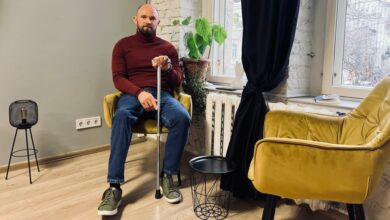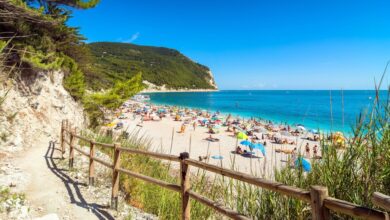Freedom Trail walked by ancestors of World War II survivors
Across the ridge, across the border, lay the Promised Land, neutral Spain – an escape, a second chance, a future.
Behind them lay Nazi-occupied France and certain incarceration or death.
During World War II, a dangerous route through the Pyrenees provided a means for hundreds of thousands of resistance fighters, civilians, Jews, Allied soldiers and escaped prisoners of war to evade Nazi pursuers.
For many, the journey up through rocky boulders and frozen glaciers was the final stretch of a long and fraught journey through wartime Europe, hidden from the German army, Gestapo secret police and SS paramilitary forces.
This month, the route that begins in France’s Ariege Pyrenees once again echoed the footsteps as 87 people climbed their way from France to Spain, including descendants of those who escaped to honor their relatives.
The Freedom Trail, whose final ascent is attacked in a zigzag path by an ice cap, is an annual “walking memorial,” as Englishman Paul Williams, a mountain guide and guardian of local history, puts it.
COMMUNICATING WITH THE PAST
Formally recognized by the French presidential decree in 1994 on the occasion of the 50th anniversary of the D-Day landings in Normandy that began the liberation of France, the trek remembers those who fled to Spain during the war.
Among past walkers is Luke Janiszewski, a 25-year-old from the Baltimore area.
“I didn’t have Nazis on my heels, I wasn’t climbing for my life,” he told CNN. But he adds: “I’ve often tried to think, ‘Wow, my great-grandfather did this with X amount of food,’ and he was only driven as, ‘I have to go to neutral Spain and back to England so I can do what I have to do.’”
Lt. Richard Christenson, a B-17 pilot, was shot down over northern France flying over the Pyrenees while the war was still going on. But he came home to spend the rest of his days with Ruth, his wife.
His daughter Kathryn, 81, who has written a book about his escape, and grandchildren Marie, 52, and Tim, 54, accompanied great-grandchildren Luke and Jake to walk the train in 2018, its 25th anniversary.
“I had never even been to Europe,” said Tim, adding that normally he would never have come alone to see the mountains. “But to follow in Grandpa’s footsteps, ‘Oh, in a moment,'” he told CNN.
“I felt a little bit connected to him, you know?” Luke, who never knew his great-grandfather, remembered.
That reunion with the past came to life at a pre-hike dinner, where the Janiszewskis met descendants of the local family Lt. Christenson rescued.
As he sat down with them, Tim reflected on how this human drama played out against the backdrop of America’s role in ending World War II.
“We came in and saved France, but your grandfather or your great-grandfather saved my grandfather trying to help save you. It’s just this beautiful web and connection that makes you feel one with everyone.”
 Richard Christenson and his wife, Ruth, are shown in a photograph by Marie Janiszewski.
Richard Christenson and his wife, Ruth, are shown in a photograph by Marie Janiszewski.
LOCAL HERO
Every year on the second weekend of July, this walk creates its own memories. This year it was especially dedicated to Paul Broué, a French resistance member and one of the founders of the Freedom Trail Association.
Born July 9, 1923, he made his escape over the Pyrenees in July 1944. Had he not died in 2020, this year would have been his 100th birthday.
Broué was the epitome of local war stories – not just the mountain guide “passeurs”, but the families who hid, escorted and died to help men like Christenson.
According to Guy Seris, a retired French colonel who is now chairman of the FTA, which organizes the four-day, 40-mile trek, about 50 percent of British and American refugees passed through this mountainous area.
Seris is also a local, from Seix, a town in the lush wooded hills that is the first stop on the trail, and where the local mayor hosts a “vin d’honneur” evening meal to mark the occasion.
“The city and the people of Seix consider it an honor given the role the commune played during the war,” Seris told CNN.
This year, in his speeches to the walkers, he stressed that those old enough who fought in the war “or lived it or mostly heard it talked about at home” had a duty to tell younger generations.
It is those memories that hikers take with them to Spain. The two countries are bound by shared mountain life – a life of swarms of pine forests and herds of bell cows that no border can separate.
Before the outbreak of World War II, the region saw mountain escape routes used in reverse, as Republican refugees crossed into France to flee General Franco’s rule at the end of the Spanish Civil War.
Although Franco was sympathetic to Germany, Spain remained neutral during World War II, largely because of its reliance on American imports. And so a blind eye was turned to those who crossed the Pyrenees.
Escaping Allied servicemen who did survive would be held in the nearest Spanish town, taken to a prison camp and released not long after.
GOOSEPUM MOMENT
US Air Force Second Lieutenant Frank McNichol was briefly held captive in the Spanish town of Isaba when he crossed over in 1944 after being shot down in a bombing raid.
His son, Joseph McNichol, 64, a retired Florida police officer, said he made a pilgrimage in 2016 to see the cell where his father had been held.
“It was a public holiday in that part of Spain, but our hotel called the mayor, who they knew, and explained the situation,” McNichol said.
“He was more than happy to come that morning and open City Hall and show me the room, which was just a dusty old storage room.”
McNichol said he was only seven when his father later died of liver failure from hepatitis, likely contracted while in France.
“I never had an adult conversation with my father about anything, not least this topic.”
Looking back on seeing the cell in the small town in Spain after crossing the border for 72 years until the day his father got there, he said, “It gives me goosebumps just talking about it.”




